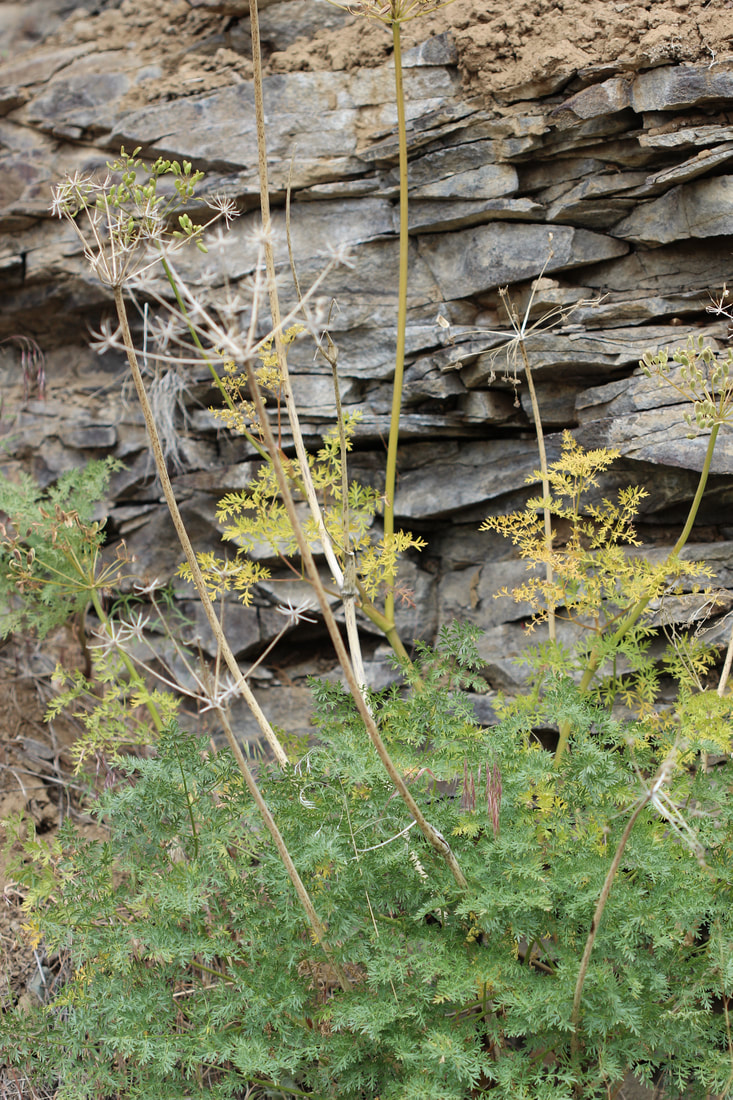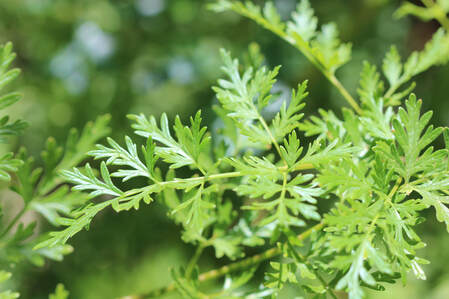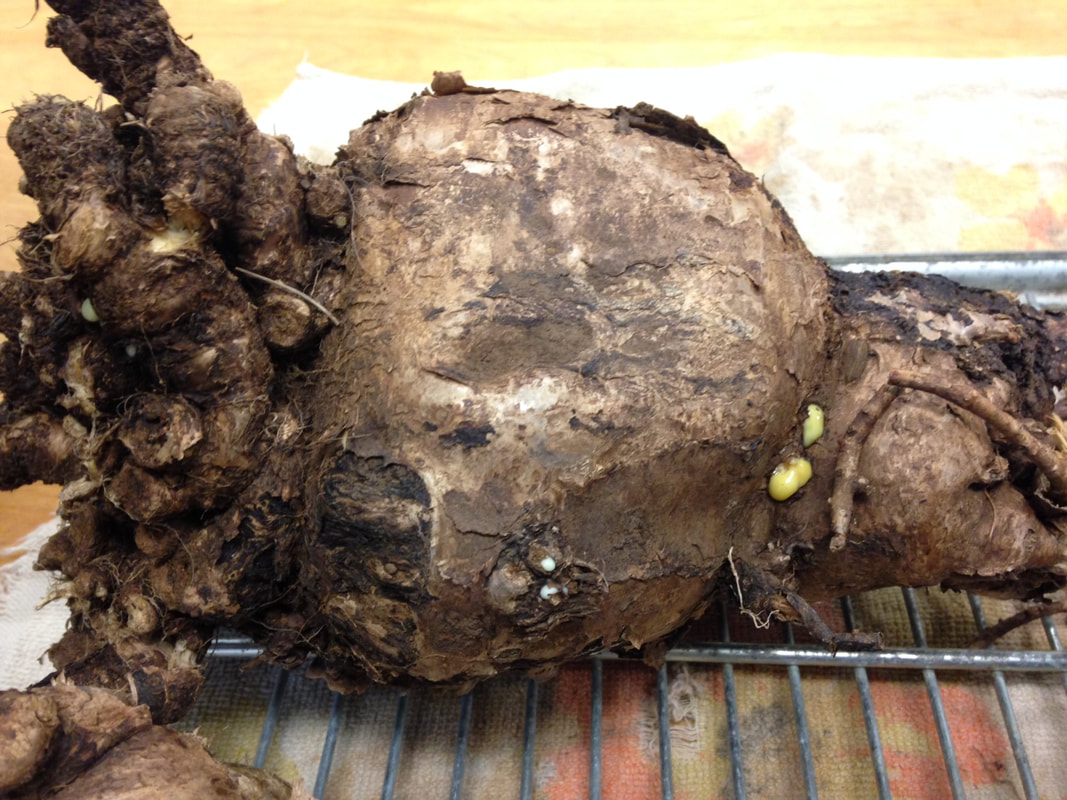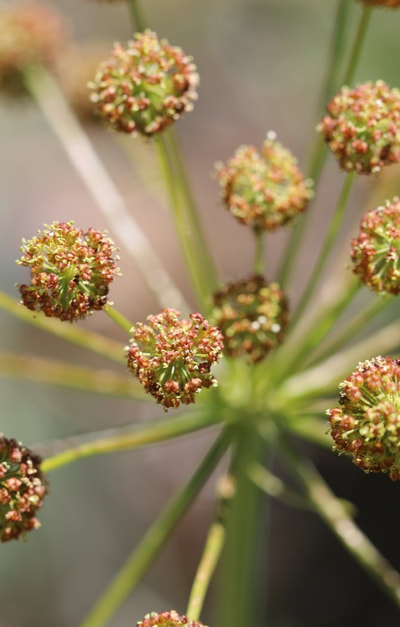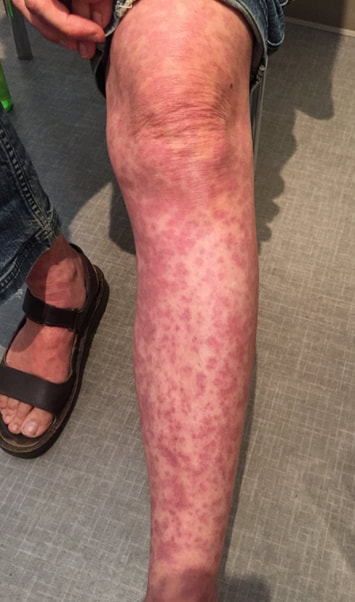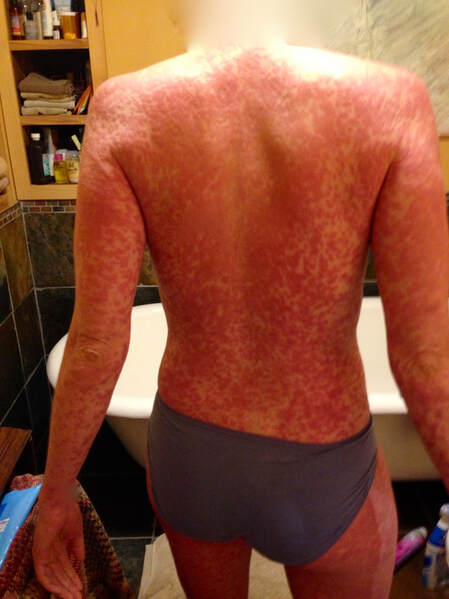by Eric Yarnell, ND, RH(AHG)
Last updated 15 Jan 2022
This monograph is protected by copyright and is intended only for use by health care professionals and students. You may link to this page if you are sharing it with others in health care, but may not otherwise copy, alter, or share this material in any way. By accessing this material you agree to hold the author harmless for any use of this information. Please donate to help support the extensive amount of time and energy it takes to create and maintain this site.
Table of Contents
Clinical Highlights
Desert parsley is a strong antimicrobial and immune stimulant.
Though it can very rarely cause a painful, transient rash, it is overall very safe.
It is quite similar to Ligusticum porteri (oshá) and other antimicrobial immune stimulants in the Apiaceae family.
Though it can very rarely cause a painful, transient rash, it is overall very safe.
It is quite similar to Ligusticum porteri (oshá) and other antimicrobial immune stimulants in the Apiaceae family.
|
|
Clinical Fundamentals
Part Used: fresh root, late spring or early summer (for ease of identification), though fall root is also potent. Dry root is an acceptable though inferior substitute.
Taste: strong, aromatic (celery-like), mildly resinous, generally considered unpleasant and usually needs corrigent(s)
Major Actions:
Major Organ System Affinities:
Major Indications:
Throughout the region where it is native, a decoction of the root was considered an important and strong treatment for "colds, sore throat and fevers" (Turner 2014). It was sometimes intentionally drunk to the point of causing vomiting (Turner 2014).
Major Constituents: overall the important compounds in this plant are poorly characterized, but they are mainly lipophilic.
Furanocoumarins
Resin
Adverse Effects: may cause nausea or vomiting, particularly with sufficiently high dosing of the decoction for more serious problems. Combination with Zingiber officinale (ginger) or other antiemetics and taking desert parsley with food help reduce this problem. It can theoretically cause photosensitivity though this is not clearly reported clinically.
A very rare patient develops a maculopapular rash all over the body from taking the medicine orally (and may develop it from cutaneous contact with the freshly harvested root). Photographs of two such patients with these rashes are listed below. The initial masculopapules coalesce into erythematous or brownish plaques that can become quite large. The rash is painful, pruritic, and unaffected by topical or oral corticosteroids. It fades over time but may take 10–14 days to reside fully (and it does not leave scars). No other treatments, including antihistamines and inflammation-modulating herbs, have made the slightest difference in quelling the rash. The author has seen four cases of the systemic rash in 25 years (if one includes one patient who got it apparently from taking oral Ligusticum porteri, its close relative), all in patients who had dosed themselves and with a wide range of products and doses. The author only knows of one case of a rash on the flexural surface of the arms of someone who was harvesting and hauling the fresh roots. All were located in the Pacific Northwest and all occurred during the winter when there was seemingly little chance of a photosensitivity rash. There is one published case study of a 74-year-old white woman developing this rash after taking a very low dose of a desert parsley extract for a few days to treat influenza (Marshall and Thornton 2018).
The late herbalist Michael Moore advanced the hypothesis that these rashes "...seem to be a short-term nitrogenous waste product overload from immunological stimulation, cytokine excess, or the waste products of viral die-off. If you use Lomatium as a 'little-drug' antiviral, trying to kill bugs as if it were some plant antibiotic without supporting the whole person, side effects can occur" (Moore 1993). He apparently but somewhat unclearly is referring to use of diaphoretic and hepatorestorative herbs in conjunction with the desert parsley. The fact that the rash can occur from topical exposure seems to argue against this theory. The author has not observed anything else supporting this idea (including that in at least two of the systemic cases observed, the patients were taking other potentially supportive herbs with the desert parsley and still got the rash) but some herbalists report getting some relief from taking hepatorestorative herbs such as Taraxacum officinale (dandelion) root after the rash commences. It doesn't seem to be an allergy problem given the lack of efficacy of anti-allergic therapies. What this rash is, who is susceptible and why, and what to do about remain great puzzles. The author feels it is so rare there is really no reason to do anything about it and that if you happen to have one of those unlikely situations where it does crop up, offer neutral baths (which do offer some temporary relief) and reassurance, help them avoid unnecessary exposure to corticosteroids, and perhaps get motivated to do research on this mystery so we can hopefully come to avoid or effectively treat it some day.
Taste: strong, aromatic (celery-like), mildly resinous, generally considered unpleasant and usually needs corrigent(s)
Major Actions:
- Antimicrobial, strong (Chou, et al. 2006)
- Immune stimulant (based on clinical experience)
- Inflammation modulating (Zamechek and Wenner 2014)
Major Organ System Affinities:
- Respiratory system
- Immune system
Major Indications:
- Respiratory tract infections, upper and lower, especially influenza (Turner 2014; Train, et al. 1957; Krebs 1920)
- Gastrointestinal tract infections
- Dermatologic infections
Throughout the region where it is native, a decoction of the root was considered an important and strong treatment for "colds, sore throat and fevers" (Turner 2014). It was sometimes intentionally drunk to the point of causing vomiting (Turner 2014).
Major Constituents: overall the important compounds in this plant are poorly characterized, but they are mainly lipophilic.
Furanocoumarins
Resin
Adverse Effects: may cause nausea or vomiting, particularly with sufficiently high dosing of the decoction for more serious problems. Combination with Zingiber officinale (ginger) or other antiemetics and taking desert parsley with food help reduce this problem. It can theoretically cause photosensitivity though this is not clearly reported clinically.
A very rare patient develops a maculopapular rash all over the body from taking the medicine orally (and may develop it from cutaneous contact with the freshly harvested root). Photographs of two such patients with these rashes are listed below. The initial masculopapules coalesce into erythematous or brownish plaques that can become quite large. The rash is painful, pruritic, and unaffected by topical or oral corticosteroids. It fades over time but may take 10–14 days to reside fully (and it does not leave scars). No other treatments, including antihistamines and inflammation-modulating herbs, have made the slightest difference in quelling the rash. The author has seen four cases of the systemic rash in 25 years (if one includes one patient who got it apparently from taking oral Ligusticum porteri, its close relative), all in patients who had dosed themselves and with a wide range of products and doses. The author only knows of one case of a rash on the flexural surface of the arms of someone who was harvesting and hauling the fresh roots. All were located in the Pacific Northwest and all occurred during the winter when there was seemingly little chance of a photosensitivity rash. There is one published case study of a 74-year-old white woman developing this rash after taking a very low dose of a desert parsley extract for a few days to treat influenza (Marshall and Thornton 2018).
The late herbalist Michael Moore advanced the hypothesis that these rashes "...seem to be a short-term nitrogenous waste product overload from immunological stimulation, cytokine excess, or the waste products of viral die-off. If you use Lomatium as a 'little-drug' antiviral, trying to kill bugs as if it were some plant antibiotic without supporting the whole person, side effects can occur" (Moore 1993). He apparently but somewhat unclearly is referring to use of diaphoretic and hepatorestorative herbs in conjunction with the desert parsley. The fact that the rash can occur from topical exposure seems to argue against this theory. The author has not observed anything else supporting this idea (including that in at least two of the systemic cases observed, the patients were taking other potentially supportive herbs with the desert parsley and still got the rash) but some herbalists report getting some relief from taking hepatorestorative herbs such as Taraxacum officinale (dandelion) root after the rash commences. It doesn't seem to be an allergy problem given the lack of efficacy of anti-allergic therapies. What this rash is, who is susceptible and why, and what to do about remain great puzzles. The author feels it is so rare there is really no reason to do anything about it and that if you happen to have one of those unlikely situations where it does crop up, offer neutral baths (which do offer some temporary relief) and reassurance, help them avoid unnecessary exposure to corticosteroids, and perhaps get motivated to do research on this mystery so we can hopefully come to avoid or effectively treat it some day.
Contraindications: Past reaction to any Apiaceae family plant is a reason to potentially avoid this plant, certainly if a patient has previously suffered from the rash described above. There is no information about the use of this herb in pregnancy or lactation. The author believes its potential benefits outweigh the unknown but likely very minimal risks to use it to short-term to treat acute infectious diseases, particularly respiratory infections, in either situation.
It is unclear if this herb is safe in people with acute or active autoimmune diseases, or those taking immunosuppressive drugs. This is based on the theorized immunostimulant actions of the plant. If a severe infection, not responsive to other treatment, is affecting someone with one of these issues, then this herb might be applicable for short-term use (a few days), when the potential benefits would outweigh the potential risks. Otherwise, it should be avoided in these circumstances until more information is available.
Drug Interactions: There are none documented or suspected.
It is unclear if this herb is safe in people with acute or active autoimmune diseases, or those taking immunosuppressive drugs. This is based on the theorized immunostimulant actions of the plant. If a severe infection, not responsive to other treatment, is affecting someone with one of these issues, then this herb might be applicable for short-term use (a few days), when the potential benefits would outweigh the potential risks. Otherwise, it should be avoided in these circumstances until more information is available.
Drug Interactions: There are none documented or suspected.
Pharmacy Essentials
Tincture: 1:2–1:3 w:v, 50–60% ethanol
Dose:
Acute, adult: 2–3 ml q 2–3 h, adjusted for body size and sensitivities, until symptoms seriously abate (usually after 2 days) then decrease to 3–4 doses a day until symptoms resolve.
Chronic, adult: 2–3 ml tid (not as often used chronically)
Children: as adult but adjusted for body size
Glycerite: 1:3–1:4 w:v, 75%+ vegetable glycerin
This herb shouldn't extract that well into glycerin, but it seems to work fine clinically. Dose the same as the tincture.
Decoction: simmer ~2–3 g of root in 250 ml of water, covered, for 15–30 min and strain. This is one "cup" or one dose. With subsequent cups the patient can adjust the water to suit their taste.
Dose:
Acute, adult: 1 cup q 3–4 h, duration and reduced frequency as described for tincture dosing above
Chronic, adult: 1 cup bid to tid (not as often used chronically)
Children: as adult but adjusted for body size
Capsules: reputable products of desert parsley by itself are not available to the author's knowledge and are not recommended. Encapsulated formulas tend to wildly underdose this herb (minimum would be 1 g per dose).
If you need help formulating with this herb, or any other, you can use the formulation tool. Remember that when using this herb in a formula, due to synergy, you can usually use less
Dose:
Acute, adult: 2–3 ml q 2–3 h, adjusted for body size and sensitivities, until symptoms seriously abate (usually after 2 days) then decrease to 3–4 doses a day until symptoms resolve.
Chronic, adult: 2–3 ml tid (not as often used chronically)
Children: as adult but adjusted for body size
Glycerite: 1:3–1:4 w:v, 75%+ vegetable glycerin
This herb shouldn't extract that well into glycerin, but it seems to work fine clinically. Dose the same as the tincture.
Decoction: simmer ~2–3 g of root in 250 ml of water, covered, for 15–30 min and strain. This is one "cup" or one dose. With subsequent cups the patient can adjust the water to suit their taste.
Dose:
Acute, adult: 1 cup q 3–4 h, duration and reduced frequency as described for tincture dosing above
Chronic, adult: 1 cup bid to tid (not as often used chronically)
Children: as adult but adjusted for body size
Capsules: reputable products of desert parsley by itself are not available to the author's knowledge and are not recommended. Encapsulated formulas tend to wildly underdose this herb (minimum would be 1 g per dose).
If you need help formulating with this herb, or any other, you can use the formulation tool. Remember that when using this herb in a formula, due to synergy, you can usually use less
Other Names
Latin Synonyms:
Current correct Latin binomial: Lomatium dissectum (Nutt) Mathias et Constance
Cynapium bigelovii Torr
Ferula dissecta (Nutt.) A Gray
Ferula dissoluta S Watson
Leptotaenia dissecta Nutt
Ligusticum apiifolium A Gray
Ligusticum apiodorum JM Coult et Rose
Pimpinella apiodora A Gray
English Common Names: desert parsley, lomatium, Indian balsam, cough root, Indian celery, Indian parsnip, desert parsnip, fern-leafed lomatium, chocolate tips, fernleaf biscuit root, biscuit root
Native American Common Names (grouped linguistically and geographically): (Turner 2014 and Meilleur, et al. 1990)
Diné bizaad (Navajo, Athabascan): xaza'alee'-tshoh ("big wild celery") (Elmore 1944)
Tsilhqot’in (Chilcotin, Athabascan): dedinydzstez ("groundhog food,” anyone who has harvested this can attest the roots have commonly been chewed on by groundhogs and possibly other rodents)
Nlaka’pamux (Thompson, Salish): təx̌qín ("bitter top/head"), tx̌tx̌ay’łp
Ńseĺxčiń (Okanagan, Salish): ʕayúʔ
Secwepemc (Shuswap, Salish): geyuʔ (root), geyeqín̓ (“the head of that carrot,” leafy aerial parts), geyqnúpyeʔ (plant)
Séliš (Spokan, Salish): č̓eyč̓i
Niimi'ipuutímt (Nez Perce, Sahaptin): títalam
Ichishkíin Sɨ́nwit (Yakama, Sahaptin): čalúkš
Sosoni' da̲i̲gwape (Shoshone, Uto-Aztecan): toza, tooza, tatsip, to:dza, tó-dzǔp
Wá:šiw ʔítlu (Washoe, isolate): doza
Ararachúupha (Karok, isolate): coma'iš
Current correct Latin binomial: Lomatium dissectum (Nutt) Mathias et Constance
Cynapium bigelovii Torr
Ferula dissecta (Nutt.) A Gray
Ferula dissoluta S Watson
Leptotaenia dissecta Nutt
Ligusticum apiifolium A Gray
Ligusticum apiodorum JM Coult et Rose
Pimpinella apiodora A Gray
English Common Names: desert parsley, lomatium, Indian balsam, cough root, Indian celery, Indian parsnip, desert parsnip, fern-leafed lomatium, chocolate tips, fernleaf biscuit root, biscuit root
Native American Common Names (grouped linguistically and geographically): (Turner 2014 and Meilleur, et al. 1990)
Diné bizaad (Navajo, Athabascan): xaza'alee'-tshoh ("big wild celery") (Elmore 1944)
Tsilhqot’in (Chilcotin, Athabascan): dedinydzstez ("groundhog food,” anyone who has harvested this can attest the roots have commonly been chewed on by groundhogs and possibly other rodents)
Nlaka’pamux (Thompson, Salish): təx̌qín ("bitter top/head"), tx̌tx̌ay’łp
Ńseĺxčiń (Okanagan, Salish): ʕayúʔ
Secwepemc (Shuswap, Salish): geyuʔ (root), geyeqín̓ (“the head of that carrot,” leafy aerial parts), geyqnúpyeʔ (plant)
Séliš (Spokan, Salish): č̓eyč̓i
Niimi'ipuutímt (Nez Perce, Sahaptin): títalam
Ichishkíin Sɨ́nwit (Yakama, Sahaptin): čalúkš
Sosoni' da̲i̲gwape (Shoshone, Uto-Aztecan): toza, tooza, tatsip, to:dza, tó-dzǔp
Wá:šiw ʔítlu (Washoe, isolate): doza
Ararachúupha (Karok, isolate): coma'iš
Interchangeability of Species
There are likely other medicinal species of Lomatium, though none appear to be as highly esteemed for medicine as the L. dissectum species. Medicinal species are large and have very aromatic, resinous sap. If the root is starchy and sweet, it isn't a medicinal species.
Ligusticum porteri (oshá), L. grayi (oshala), and the roots of other species in this genus have very similar effects and potency, and seem nearly or entirely interchangeable with desert parsley. Another similar Apiaceae family plant is Osmorhiza occidentalis (western sweet cicely), the root of which is also fairly similar but actually tastes fairly pleasant (as long as the patient doesn't mind the somewhat licorice-like flavor). The author has been using more and more of this species and less and less Lomatium or Ligusticum over the years given their interchangeability (and because the Osmorhiza is so much more palatable). The use of a combination of western sweet cicely and desert parsley roots to treat a range of respiratory infections, as well as gonorrhea, was apparently traditional among indigenous peoples of Nevada (Train, et al. 1957).
Ligusticum porteri (oshá), L. grayi (oshala), and the roots of other species in this genus have very similar effects and potency, and seem nearly or entirely interchangeable with desert parsley. Another similar Apiaceae family plant is Osmorhiza occidentalis (western sweet cicely), the root of which is also fairly similar but actually tastes fairly pleasant (as long as the patient doesn't mind the somewhat licorice-like flavor). The author has been using more and more of this species and less and less Lomatium or Ligusticum over the years given their interchangeability (and because the Osmorhiza is so much more palatable). The use of a combination of western sweet cicely and desert parsley roots to treat a range of respiratory infections, as well as gonorrhea, was apparently traditional among indigenous peoples of Nevada (Train, et al. 1957).
Advanced Clinical Information
Additional Actions:
Some sources seem to suggest desert parsley is only an antiviral. This is just not true, based both on the research cited here and on the author's experience (and that of many other clinicians the author has consulted). It is, in fact, a broad-acting antimicrobial.
It is notable that in vitro, desert parsley inhibited a cytokine (CXCL-10) strongly associated with cytokine storms that can kill people with influenza, CoVid-19, or other severe viral infections (Zamechek and Wenner 2014).
Additional Indications: (Moore 1993)
The root was traditionally chopped and placed in streams as a temporary fish poison by various Interior Plateau Salish people (Turner 2014 and Meilleur, et al. 1990).
Cooked and mashed roots were traditionally applied as a poultice to joints affected by rheumatism and arthritis (Turner 2014). Some Indigenous people in the Pacific Northwest used a steam bath made from the root for pneumonia, rheumatism, strains and sprains, and pain in general (Turner 2014; Turner, et al. 1980). This bath was prepared by roasting the roots in a fire until warm then crushing them, digging a trench and filling it with hot rocks that were buried in earth then covered with the root mash, and finally the patient was placed on the roots and covered with a robe (Turner 2014; Turner, et al. 1980).
Among the Wá:šišiw (Washoe) people of what is now Nevada, it was traditional to smoke the pulverized root, sometimes mixed with tobacco, for nasal congestion or asthma (Train, et al. 1957). Also the smoke from roots burning in a bed of hot coals was inhaled for this purpose.
- Antibacterial (Carlson and Douglas 1948; Matson, et al. 1949)
- Antifungal (Carlson and Douglas 1948; Meepagala, et al. 2005)
- Antimycobacterial (Matson, et al. 1949)
- Antiretroviral (Lee, et al. 1995)
- Antiviral (McCutcheon, et al. 1995)
- Phytotoxic, weed-suppressing (Meepagala, et al. 2005)
Some sources seem to suggest desert parsley is only an antiviral. This is just not true, based both on the research cited here and on the author's experience (and that of many other clinicians the author has consulted). It is, in fact, a broad-acting antimicrobial.
It is notable that in vitro, desert parsley inhibited a cytokine (CXCL-10) strongly associated with cytokine storms that can kill people with influenza, CoVid-19, or other severe viral infections (Zamechek and Wenner 2014).
Additional Indications: (Moore 1993)
- Asthma (Train, et al. 1957)
- Candidiasis
- CMV infection
- EBV infection
- Gingivitis
- Gonorrhea, combined with other herbs (Train, et al. 1957)
- HIV infection (this is of little relevance in the age of highly-active antiretroviral drugs)
- Impetigo
- Periodontal disease
- Rheumatism
- Shigellosis
- Tuberculosis (Train, et al. 1957)
- Vaginitis, infectious
The root was traditionally chopped and placed in streams as a temporary fish poison by various Interior Plateau Salish people (Turner 2014 and Meilleur, et al. 1990).
Cooked and mashed roots were traditionally applied as a poultice to joints affected by rheumatism and arthritis (Turner 2014). Some Indigenous people in the Pacific Northwest used a steam bath made from the root for pneumonia, rheumatism, strains and sprains, and pain in general (Turner 2014; Turner, et al. 1980). This bath was prepared by roasting the roots in a fire until warm then crushing them, digging a trench and filling it with hot rocks that were buried in earth then covered with the root mash, and finally the patient was placed on the roots and covered with a robe (Turner 2014; Turner, et al. 1980).
Among the Wá:šišiw (Washoe) people of what is now Nevada, it was traditional to smoke the pulverized root, sometimes mixed with tobacco, for nasal congestion or asthma (Train, et al. 1957). Also the smoke from roots burning in a bed of hot coals was inhaled for this purpose.
Botanical Information
Botanical Description:
This root-perennial herb grows up to 1.4 m tall. Leaves are mostly basal (rarely cauline or on the stem), triangular ovate and ternate-pinnately, very finely dissected, each leaflet 2–22 mm long. The leaves and stems range from glabrous (smooth) to glaucous (waxy) to puberulent (covered with fine hairs). It has a compound umbel inflorescence with peduncles 15–60 cm long. It typically has 10–30 rays in an umbel that spread out quite a bit. Each flower is tiny with maroon-red to purple (occasionally yellow or white) petals, 5 stamens, 1 pistil, and an inferior, 2-chambered ovary. Flowers generally appear May–July. The fruit is a schizocarp, consisting of two green halves that look a lot like pumpkin seeds with minimal ribs that split apart (each half being called a mericarp) and turn to very dry and light brown seeds. Each flattened to concave seed is 12–16 mm long.
It is crucial to be able to differentiate this plant from the extremely poisonous members of the Apiaceae family is your are going to harvest it. A few of these are noted here, but further knowledge and study are essential before harvesting this plant.
Cicuta virosa and C. douglasii (water hemlock): Generally grows only in or near running water and generally at lower elevations. Root has mousy odor, is chambered, and red-yellow resin. Leaves pinnately compound divided 1–3 times with lanceolate-oblong leaflets. Leaflet veins tend to point to notches between serrations. Ridged, hairless schizocarp. Arguably the most poisonous plants in North America (just touching them may cause symptom in sensitive people).
Conium maculatum (poison hemlock): Grows at lower altitudes as an Eurasian weed in disturbed land. Stem spotted and hairless. Finely divided leaves Root has mousy, off odor and has hollow chambers. Fruit (wavy-ridged schizocarp) and habit similar to L. grayi. Poison Hemlock is so potentially toxic, it should not even be touched with bare skin due to the risk of harm.
Conioselinum mexicanum (hemlock parsley): grows in wetter conditions usually than lomatium (and never above 2500 m and roots have minimal odor) so caution is warranted.
Native Habitat and Current Range
Desert parsley prefers to grow on partially wooded or brush-covered slopes from 150 to 3000 m elevation on Vancouver Island, in southern British Columbia and Alberta, eastern Washington and Oregon, northeastern California (Sierra Nevadas), and the northern Rocky Mountains.
This root-perennial herb grows up to 1.4 m tall. Leaves are mostly basal (rarely cauline or on the stem), triangular ovate and ternate-pinnately, very finely dissected, each leaflet 2–22 mm long. The leaves and stems range from glabrous (smooth) to glaucous (waxy) to puberulent (covered with fine hairs). It has a compound umbel inflorescence with peduncles 15–60 cm long. It typically has 10–30 rays in an umbel that spread out quite a bit. Each flower is tiny with maroon-red to purple (occasionally yellow or white) petals, 5 stamens, 1 pistil, and an inferior, 2-chambered ovary. Flowers generally appear May–July. The fruit is a schizocarp, consisting of two green halves that look a lot like pumpkin seeds with minimal ribs that split apart (each half being called a mericarp) and turn to very dry and light brown seeds. Each flattened to concave seed is 12–16 mm long.
It is crucial to be able to differentiate this plant from the extremely poisonous members of the Apiaceae family is your are going to harvest it. A few of these are noted here, but further knowledge and study are essential before harvesting this plant.
Cicuta virosa and C. douglasii (water hemlock): Generally grows only in or near running water and generally at lower elevations. Root has mousy odor, is chambered, and red-yellow resin. Leaves pinnately compound divided 1–3 times with lanceolate-oblong leaflets. Leaflet veins tend to point to notches between serrations. Ridged, hairless schizocarp. Arguably the most poisonous plants in North America (just touching them may cause symptom in sensitive people).
Conium maculatum (poison hemlock): Grows at lower altitudes as an Eurasian weed in disturbed land. Stem spotted and hairless. Finely divided leaves Root has mousy, off odor and has hollow chambers. Fruit (wavy-ridged schizocarp) and habit similar to L. grayi. Poison Hemlock is so potentially toxic, it should not even be touched with bare skin due to the risk of harm.
Conioselinum mexicanum (hemlock parsley): grows in wetter conditions usually than lomatium (and never above 2500 m and roots have minimal odor) so caution is warranted.
Native Habitat and Current Range
Desert parsley prefers to grow on partially wooded or brush-covered slopes from 150 to 3000 m elevation on Vancouver Island, in southern British Columbia and Alberta, eastern Washington and Oregon, northeastern California (Sierra Nevadas), and the northern Rocky Mountains.
Harvesting, Cultivation, and Ecology
Cultivation: So far this plant is not known to be in major cultivation, and almost all raw materials come from wildcrafting. That being said, there is extensive documentation on how to grow it within its native range (at altitude, with similar oils and either natural amounts of rainfall or with supplemental drip irrigation) (Shock, et al. 2012).
Wildcrafting: This is currently the only source for this plant. It should be harvested from well-established, large populations, taking less than one tenth of the plants in an area. Consider replanting some part of root harvested on site, or leaving some root behind, to help with regeneration. These are fairly long-lived plants, and very large roots likely represent decades of growth.
Ecological Status: Though listed on the United Plant Savers at risk list, lomatium is still abundant in much of its habitat, which is little affected by human activity as it is generally in the mountains. The concern seems to be that with habitat loss (including from the global climate emergency) or increased popularity and harvesting, the plant could not withstand heavy use.
NatureServe ranks desert parsley as G4 apparently secure as of 22 July 2016. It is so widespread in its range that most sources do not provide an estimate of number of plants, making it somewhat hard to tell if there has been any decline in the species with growing wildcrafting for medicine.
Wildcrafting: This is currently the only source for this plant. It should be harvested from well-established, large populations, taking less than one tenth of the plants in an area. Consider replanting some part of root harvested on site, or leaving some root behind, to help with regeneration. These are fairly long-lived plants, and very large roots likely represent decades of growth.
Ecological Status: Though listed on the United Plant Savers at risk list, lomatium is still abundant in much of its habitat, which is little affected by human activity as it is generally in the mountains. The concern seems to be that with habitat loss (including from the global climate emergency) or increased popularity and harvesting, the plant could not withstand heavy use.
NatureServe ranks desert parsley as G4 apparently secure as of 22 July 2016. It is so widespread in its range that most sources do not provide an estimate of number of plants, making it somewhat hard to tell if there has been any decline in the species with growing wildcrafting for medicine.
References
Carlson JH, Douglas HG (1948) "Antibiotic agents separated from the root of lace-leaved leptotaenia" J Bacteriol 55:615–21.
Chou SC, Everngam MC, Sturtz G, Beck JJ (2006) "Antibacterial activity of components from Lomatium californicum" Phytother Res 20(2):153–6.
Elmore FH (1944) Ethnobotany of the Navajo, A Monograph of the University of New Mexico and the School of American Research (University of New Mexico Press).
Krebs ET (1920) "An Indian remedy for influenza" Bull Nevada State Board Health 1:7–9.
Lee TT, Kashiwada Y, Huang L, et al. (1995) "Suksdorfin: An anti-HIV principle from Lomatium suksdorfii, its structure-activity correlation with related coumarins, and synergistic effects with anti-AIDS nucleosides" Bioorg MedChem 2(10):1051–6.
Marshall KD, Thornton SL (2018) "Worse than the disease? The rash of Lomatium dissectum" Kans J Med 11(2):1–6.
Matson GA, Ravve A, Sugihara JM, Burke WJ (1949) "Antibiotic studies on an extract from Leptotaenia multifeda [sic]" J Clin Invest 28:903–8.
McCutcheon AR, Roberts TE, Gibbons E, et al. (1995) "Antiviral screening of British Columbian medicinal plants" J Ethnopharmacol 49(2):101–10.
Meepagala KM, Sturtz G, Wedge DE, Schrader KK, Duke SO (2005) "Phytotoxic and antifungal compounds from two Apiaceae species, Lomatium californicum and Ligusticum hultenii, rich sources of Z-ligustilide and apiol, respectively" J Chem Ecol 31(7):1567–78.
Meilleur BA, Hunn ES, Cox RL (1990) "Lomatium dissectum (Apiaceae): Multi-purpose plant of the Pacific Northwest" J Ethnobiol 10(1):1–20.
Moore M (1993) Medicinal Plants of the Pacific West (Santa Fe: Red Crane Books)
Shock MP, Shock CC, Feibert EBG, et al. (2012) "Cultivation and irrigation of fernleaf biscuitroot (Lomatium dissectum) for seed production" HortScience 47(10):1525–8.
Train P, Henrichs JR, Archer WA (1957) "Medicinal uses of plants by Indian tribes of Nevada, revised edition, with summary of pharmacological research" Contributions Toward a Flora of Nevada 45:1–139.
Turner NJ (2014) Ancient Pathways, Ancestral Knowledge: Ethnobotany and Ecological Wisdom of Indigenous Peoples of Northwestern North America. 2 Volumes (McGill-Queen’s University Press).
Turner NJ, Bouchard R, Kennedy DID (1980) Ethnobotany of the Okanagan-Colville Indians of British Columbia and Washington. Occasional papers of the British Columbia Provincial Museum Number 21 (Province of British Columbia, Ministry of Provincial Secretary and Government Services).
Zamechek D, Wenner CA (2014) “Lomatium dissectum inhibits secretion of CXCL10, a chemokine associated with poor prognosis in highly pathogenic influenza A infection” J Restorative Med 3:104–11.
Chou SC, Everngam MC, Sturtz G, Beck JJ (2006) "Antibacterial activity of components from Lomatium californicum" Phytother Res 20(2):153–6.
Elmore FH (1944) Ethnobotany of the Navajo, A Monograph of the University of New Mexico and the School of American Research (University of New Mexico Press).
Krebs ET (1920) "An Indian remedy for influenza" Bull Nevada State Board Health 1:7–9.
Lee TT, Kashiwada Y, Huang L, et al. (1995) "Suksdorfin: An anti-HIV principle from Lomatium suksdorfii, its structure-activity correlation with related coumarins, and synergistic effects with anti-AIDS nucleosides" Bioorg MedChem 2(10):1051–6.
Marshall KD, Thornton SL (2018) "Worse than the disease? The rash of Lomatium dissectum" Kans J Med 11(2):1–6.
Matson GA, Ravve A, Sugihara JM, Burke WJ (1949) "Antibiotic studies on an extract from Leptotaenia multifeda [sic]" J Clin Invest 28:903–8.
McCutcheon AR, Roberts TE, Gibbons E, et al. (1995) "Antiviral screening of British Columbian medicinal plants" J Ethnopharmacol 49(2):101–10.
Meepagala KM, Sturtz G, Wedge DE, Schrader KK, Duke SO (2005) "Phytotoxic and antifungal compounds from two Apiaceae species, Lomatium californicum and Ligusticum hultenii, rich sources of Z-ligustilide and apiol, respectively" J Chem Ecol 31(7):1567–78.
Meilleur BA, Hunn ES, Cox RL (1990) "Lomatium dissectum (Apiaceae): Multi-purpose plant of the Pacific Northwest" J Ethnobiol 10(1):1–20.
Moore M (1993) Medicinal Plants of the Pacific West (Santa Fe: Red Crane Books)
Shock MP, Shock CC, Feibert EBG, et al. (2012) "Cultivation and irrigation of fernleaf biscuitroot (Lomatium dissectum) for seed production" HortScience 47(10):1525–8.
Train P, Henrichs JR, Archer WA (1957) "Medicinal uses of plants by Indian tribes of Nevada, revised edition, with summary of pharmacological research" Contributions Toward a Flora of Nevada 45:1–139.
Turner NJ (2014) Ancient Pathways, Ancestral Knowledge: Ethnobotany and Ecological Wisdom of Indigenous Peoples of Northwestern North America. 2 Volumes (McGill-Queen’s University Press).
Turner NJ, Bouchard R, Kennedy DID (1980) Ethnobotany of the Okanagan-Colville Indians of British Columbia and Washington. Occasional papers of the British Columbia Provincial Museum Number 21 (Province of British Columbia, Ministry of Provincial Secretary and Government Services).
Zamechek D, Wenner CA (2014) “Lomatium dissectum inhibits secretion of CXCL10, a chemokine associated with poor prognosis in highly pathogenic influenza A infection” J Restorative Med 3:104–11.
